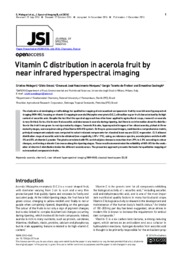Vitamin C distribution in acerola fruit by near infrared hyperspectral imaging.
Vitamin C distribution in acerola fruit by near infrared hyperspectral imaging.
Author(s): MALEGORI, C.; GRASSI, S.; MARQUES, E. J. N.; FREITAS, S. T. de; CASIRAGHI, E.
Summary: The study aims at developing a methodology for qualitative mapping of nutraceutical compounds in fruit by near infrared hyperspectral imaging (NIR-HSI), focusing on vitamin C mapping in acerola (Malpighia emarginata D.C.), a Brazilian super-fruit characterised by its high content of ascorbic acid. Despite the fact that the spectral approach has often been applied to agricultural crops, research on acerola is very limited. So far, it is known that ascorbic acid decreases in acerola during ripening, but there is no information about its distribution in the fruit from green to red ripe maturity stages. Towards this aim, hyperspectral images of ten sliced acerola, picked at three maturity stages, were acquired using a SisuChema NIR-HSI system. On the pre-processed images, combined in a omprehensive matrix, principal component analysis was computed to select relevant components for classical least square (CLS) regression. CLS allowed distribution maps of ascorbic acid to be obtained (non-negativity, LOF = 1.9%), using, as reference spectra, acerola juices enriched with 0% and 5% of vitamin C powder. The pixels correlated with 5%-enriched juice showed a reduction from 29% to 6.5% according to colour changes, confirming a vitamin C decrease along the ripening stages. These results demonstrated the reliability of NIR-HSI for the evaluation of vitamin C distribution inside the different acerola areas. The presented approach presents the basis for qualitative mapping of nutraceutical compounds in fruits.
Publication year: 2016
Types of publication: Journal article
Unit: Embrapa Semi-arid Region
Observation
Some of Embrapa's publications are published as ePub files. To read them, use or download one of the following free software options to your computer or mobile device. Android: Google Play Books; IOS: iBooks; Windows and Linux: Calibre.
Access other publications
Access the Agricultural Research Database (BDPA) to consult Embrapa's full library collection and records.
Visit Embrapa Bookstore to purchase books and other publications sold by Embrapa.

